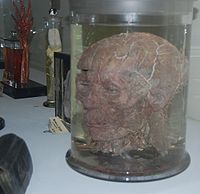
Friedrich Schlemm
Encyclopedia
Friedrich Schlemm was a German anatomist who was professor at the University of Berlin.
He was born in Salzgitter
. As his family could not afford higher education, he was apprenticed to a barber-surgeon in Braunschweig. This gave him the opportunity to study anatomy and surgery at the local Anatomico-Surgical Institute. In 1821 he received his medical doctorate from the University of Berlin, and became Prosector
at the university in 1823. In 1829 he became "professor extraordinary" of anatomy, and attained the title of "full professor" in 1833.
 Recently discovered archival sources demonstrate that, in June 1816, Schlemm and a fellow student disinterred the body of a deceased woman late at night in a Braunschweig churchyard to bring the body to this Institute and study the effects of rickets on the woman's bones. They were caught and sentenced to 4 weeks of prison. Subsequently, Schlemm left Braunschweig and found work as a low-rank army surgeon in Berlin. Professor Rudolphi, the director of the Berlin Institute of Anatomy, took note of Schlemm's manual dexterity in anatomical dissection and supported his impressive career. Schlemm eventually became full professor of anatomy in 1833 and spent his remaining 25 years in Berlin with a focus on teaching students and training surgeons. As historical background information is largely lacking in this regard, it is impossible to decide whether Schlemm's episode of grave robbing was a solitary instance or a more common method of acquiring bodies for anatomical instruction in early 19th century Germany.
Recently discovered archival sources demonstrate that, in June 1816, Schlemm and a fellow student disinterred the body of a deceased woman late at night in a Braunschweig churchyard to bring the body to this Institute and study the effects of rickets on the woman's bones. They were caught and sentenced to 4 weeks of prison. Subsequently, Schlemm left Braunschweig and found work as a low-rank army surgeon in Berlin. Professor Rudolphi, the director of the Berlin Institute of Anatomy, took note of Schlemm's manual dexterity in anatomical dissection and supported his impressive career. Schlemm eventually became full professor of anatomy in 1833 and spent his remaining 25 years in Berlin with a focus on teaching students and training surgeons. As historical background information is largely lacking in this regard, it is impossible to decide whether Schlemm's episode of grave robbing was a solitary instance or a more common method of acquiring bodies for anatomical instruction in early 19th century Germany.
Schlemm was known for his pathological
studies on cadaver
s. He was the first to discover the cornea
l nerves of the eye, which he describes in his 1830 treatise named Arteriarum capitis superficialum icon nova. He is known today for the eponymous Schlemm's canal
, which is a channel in the eye that collects aqueous humor from the anterior chamber
and delivers it into the bloodstream.
He was born in Salzgitter
Salzgitter
Salzgitter is an independent city in southeast Lower Saxony, Germany, located between Hildesheim and Braunschweig. Together with Wolfsburg and Braunschweig, Salzgitter is one of the seven Oberzentren of Lower Saxony...
. As his family could not afford higher education, he was apprenticed to a barber-surgeon in Braunschweig. This gave him the opportunity to study anatomy and surgery at the local Anatomico-Surgical Institute. In 1821 he received his medical doctorate from the University of Berlin, and became Prosector
Prosector
A prosector is a person with the special task of preparing a dissection for demonstration, usually in medical schools or hospitals. Many important anatomists began their careers as prosectors working for lecturers and demonstrators in anatomy and pathology....
at the university in 1823. In 1829 he became "professor extraordinary" of anatomy, and attained the title of "full professor" in 1833.

Schlemm was known for his pathological
Pathology
Pathology is the precise study and diagnosis of disease. The word pathology is from Ancient Greek , pathos, "feeling, suffering"; and , -logia, "the study of". Pathologization, to pathologize, refers to the process of defining a condition or behavior as pathological, e.g. pathological gambling....
studies on cadaver
Cadaver
A cadaver is a dead human body.Cadaver may also refer to:* Cadaver tomb, tomb featuring an effigy in the form of a decomposing body* Cadaver , a video game* cadaver A command-line WebDAV client for Unix....
s. He was the first to discover the cornea
Cornea
The cornea is the transparent front part of the eye that covers the iris, pupil, and anterior chamber. Together with the lens, the cornea refracts light, with the cornea accounting for approximately two-thirds of the eye's total optical power. In humans, the refractive power of the cornea is...
l nerves of the eye, which he describes in his 1830 treatise named Arteriarum capitis superficialum icon nova. He is known today for the eponymous Schlemm's canal
Schlemm's canal
Schlemm's canal, also known as canal of Schlemm or the scleral venous sinus, is a circular channel in the eye that collects aqueous humor from the anterior chamber and delivers it into the bloodstream via the anterior ciliary veins....
, which is a channel in the eye that collects aqueous humor from the anterior chamber
Anterior chamber
The anterior chamber is the fluid-filled space inside the eye between the iris and the cornea's innermost surface, the endothelium. Aqueous humor is the fluid that fills the anterior chamber. Hyphema and glaucoma are two main pathologies in this area. In hyphema, blood fills the anterior chamber...
and delivers it into the bloodstream.

